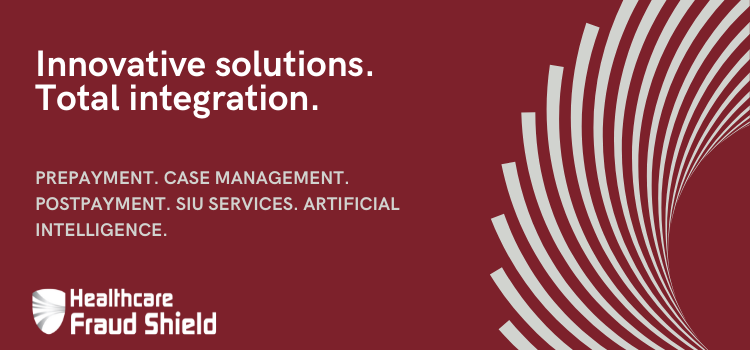This post is sponsored by Healthcare Fraud Shield
Combating fraud, waste and abuse in health care is complex and difficult. Employing a solution that combines artificial intelligence, targeted analytics and subject matter experts can help payers understand the intricacies behind FWA investigations, identify FWA patterns in claims and the prepayment phase, simplify processes and ensure appropriate payment of claims. SmartBrief spoke with Karen Weintraub, executive vice president of FWA solution provider Healthcare Fraud Shield, to learn more.
Why should health care payers employ both artificial intelligence and targeted analytics to help identify fraud, waste and abuse and ensure payment integrity?
I think it’s helpful to break down the meaning of these terms first. Targeted analytics are algorithms that identify known patterns of behavior such as trends, outliers, spikes in various data attributes or established billing scenarios that are very specific. These behaviors are often based on well-established industry medical policies, coding guidelines or accepted views on what has been deemed inappropriate. Comprehensive rule libraries incorporate at least a decade of knowledge on well-known FWA schemes and provide highly detailed explanations on them and what needs to be investigated. Targeted analytics require human intelligence – experience, industry knowledge and a bit of intuition.
Artificial intelligence – specifically, using our product, AIShield – supports the identification of previously unknown fraud schemes by incorporating both unsupervised anomaly detection across a feature set that captures different aspects of billing behavior and supervised detection from actual fraud cases. AI tools are designed to replicate the thought process of an experienced investigator by looking for anomalies in the frequency or intensity of services, types of procedures or diagnosis codes, combination of services and temporal patterns in claim activity. AI can augment and leverage comprehensive rules-based analytics into a powerful, all-encompassing approach. Using both approaches together is the most efficient – and beneficial – way of capturing potentially fraudulent behavior and bolstering general payment integrity efforts to ensure claims were paid appropriately.
How can subject matter experts help payers spot and curb FWA?
SMEs are integral to the process. Health care is complicated, and each payer does things differently. There are nuances among policies, provider contracts, member evidence of coverage allowances, varying regulatory requirements based on the product type or line of business, and more. Here is a common example: An FWA software solution identifies a provider billing a specific code, and it doesn’t make sense when compared with their peers or general benchmarks. However, that provider may have a contract that states providers should only use a specific billing code regardless of which service is performed. So, it takes someone who understands these nuances and scenarios to think through why an outlier may be substantiated – or unsubstantiated.
How can an integrated solution help payers streamline FWA processes, as well as claims processing and payment operations?
HCFS designed an integrated solution for payers consisting of post-payment analytics, pre-payment analytics and workflows, AI, case management and a reporting tool. All parts of the system communicate with one another, allowing quick identification of suspect behaviors regarding medical, dental and pharmacy billing through post-payment analytics. The analytics can also be applied to prepayment to highlight individual claims that should not be paid based on specific criteria developed in real time. Additionally, advanced analytics can be applied to claims submitted on prepay to identify suspect patterns. Prepayment and post-payment analytics complement each other, providing an efficient way to detect and prevent inappropriate payments. Clients get full access and real-time control to configure what should be monitored in a prepayment environment, and the results can be communicated back to the payer’s claims/operations area to ensure timely payment and/or denial of claims. Integration allows clients to quickly see the time spent – and saved – using advanced workflows, return on investment and insight into daily inventory.
What benefits can this type of solution provide in terms of identifying FWA across multiple departments?
FWA areas, typically referred to as Special Investigations Units, review of a variety of issues. While the focus may be potential FWA, investigations also aim at understanding overall utilization, contracts, underwriting, medical informatics, appeals and grievances, and more. Legacy FWA solutions only focus on schemes. HCFS incorporates FWA schemes, as well as a variety of dashboards and analytics that quickly give key information about these other areas. As a result, the system provides a comprehensive view of the key elements surrounding potential FWA and also provides valuable insights.
How does this solution help payers incorporate a prevent-and-pay approach that complements a post-payment analytic tool?
Pay and chase is difficult and complex. It is not impossible, but you are less likely to recoup 100% of an identified overpayment. However, post-payment analytics are extremely valuable in identifying behaviors to monitor in a prepayment process. Simply, you need to keep doing both. Our solution provides the ability to monitor patterns and outliers on post-payment, convert post-payment analytics to prepayment in real time, create prepayment analytics or algorithms in real time, and then continue to monitor for new behaviors on post-payment and/or identify systemic deficiencies in the claims system.
Karen Weintraub is executive vice president at Healthcare Fraud Shield. Weintraub is responsible for the design and development of the company’s health care fraud detection software products and services. Weintraub provides subject matter expertise on system design and workflow, business rule development, data mining and fraud outlier algorithms, as well as Special Investigation Unit policies and procedures. Before joining HCFS, Weintraub managed SIU services and investigations at technology vendor and private payer companies.
Watch this video to learn more about Healthcare Fraud Shield:
